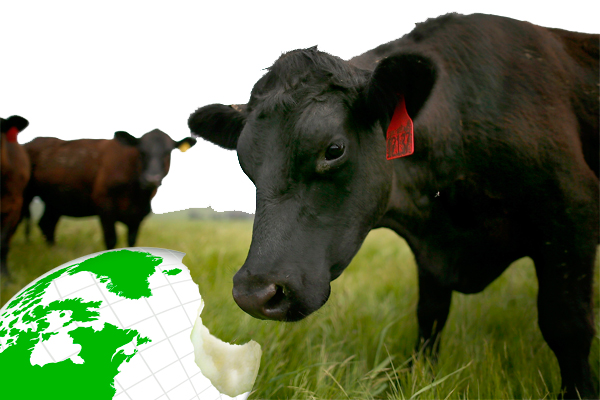Environmental costs for beef larger than expected

Beef is by far the most environmentally costly animal protein. This is according to new research that appeared in the Proceedings of the National Academy of Sciences (PNAS).
Dr Ron Milo of the Institute’s Plant Sciences Department, together with his research student Alon Shepon, in collaboration with Tamar Makov of Yale University and Dr Gidon Eshel in New York, asked which types of animal based-food should one consume, environmentally speaking. Though many studies have addressed parts of the issue, none has done a thorough, comparative study that gives a multi-perspective picture of the environmental costs of food derived from animals.
Calculate environmental inputs
The team looked at the five main sources of protein in the American diet: dairy, beef, poultry, pork and eggs. Their idea was to calculate the environmental inputs – the costs – per nutritional unit: a calorie or gram of protein. The main challenge the team faced was to devise accurate, faithful input values. The environmental inputs the team considered included land use, irrigation water, greenhouse gas emissions, and nitrogen fertiliser use. Each of these costs is a complex environmental system. For example, land use, in addition to tying up this valuable resource in agriculture, is the main cause of biodiversity loss. Nitrogen fertiliser creates water pollution in natural waterways.
When the numbers were in, including those for the environmental costs of different kinds of feed (pasture, roughage such as hay, and concentrates such as corn), the team developed equations that yielded values for the environmental cost – per calorie and then per unit of protein, for each food.
Surprise was in the gap size
The calculations showed that the biggest culprit, by far, is beef. That was no surprise, say Milo and Shepon. The surprise was in the size of the gap: In total, eating beef is more costly to the environment by an order of magnitude – about ten times on average – than other animal-derived foods, including pork and poultry. Cattle require on average 28 times more land and 11 times more irrigation water, are responsible for releasing 5 times more greenhouse gases, and consume 6 times as much nitrogen, as eggs or poultry. Poultry, pork, eggs and dairy all came out fairly similar. That was also surprising, because dairy production is often thought to be relatively environmentally benign. But the research shows that the price of irrigating and fertilising the crops fed to milk cows – as well as the relative inefficiency of cows in comparison to other livestock – jacks up the cost significantly.
Implications
Milo believes that this study could have a number of implications. In addition to helping individuals make better choices about their diet, it should hopefully help inform agricultural policy. And the tool the team has created for analysing the environmental costs of agriculture can be expanded and refined to be applied, for example, to understanding the relative cost of plant-based diets, or those of other nations. In addition to comparisons, it can point to areas that might be improved. Models based on this study can help policy makers decide how to better ensure food security through sustainable practices.
[Source: ScienceDaily]











